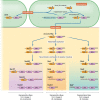Role of distinct type-IV-secretion systems and secreted effector sets in host adaptation by pathogenic Bartonella species
- PMID: 30644157
- PMCID: PMC6519360
- DOI: 10.1111/cmi.13004
Role of distinct type-IV-secretion systems and secreted effector sets in host adaptation by pathogenic Bartonella species
Abstract
The α-proteobacterial genus Bartonella comprises a large number of facultative intracellular pathogens that share a common lifestyle hallmarked by hemotrophic infection and arthropod transmission. Speciation in the four deep-branching lineages (L1-L4) occurred by host adaptation facilitating the establishment of long lasting bacteraemia in specific mammalian reservoir host(s). Two distinct type-IV-secretion systems (T4SSs) acquired horizontally by different Bartonella lineages mediate essential host interactions during infection and represent key innovations for host adaptation. The Trw-T4SS confined to the species-rich L4 mediates host-specific erythrocyte infection and likely has functionally replaced flagella as ancestral virulence factors implicated in erythrocyte colonisation by bartonellae of the other lineages. The VirB/VirD4-T4SS translocates Bartonella effector proteins (Bep) into various host cell types to modulate diverse cellular and innate immune functions involved in systemic spreading of bacteria following intradermal inoculation. Independent acquisition of the virB/virD4/bep locus by L1, L3, and L4 was likely driven by arthropod vectors associated with intradermal inoculation of bacteria rather than facilitating direct access to blood. Subsequently, adaptation to colonise specific niches in the new host has shaped the evolution of complex species-specific Bep repertoires. This diversification of the virulence factor repertoire of Bartonella spp. represents a remarkable example for parallel evolution of host adaptation.
Keywords: Bartonella; Bep effector proteins; Trw; VirB/VirD4; host adaptation; type-IV-secretion systems.
© 2019 The Authors Cellular Microbiology Published by John Wiley & Sons Ltd.
Figures


References
-
- Berglund, E. C. , Frank, A. C. , Calteau, A. , Vinnere Pettersson, O. , Granberg, F. , Eriksson, A. S. , … Andersson, S. G. (2009). Run‐off replication of host‐adaptability genes is associated with gene transfer agents in the genome of mouse‐infecting Bartonella grahamii . PLoS Genetics, 5, e1000546 10.1371/journal.pgen.1000546 - DOI - PMC - PubMed
-
- Bisch, G. , Neuvonen, M.M. , Pierce, N.E. , Russell, J.A. , Koga, R. , Sanders, J.G. , . . . Andersson, S.G.E. (2018). Genome evolution of Bartonellaceae symbionts of ants at the opposite ends of the trophic scale. Genome Biology and Evolution 10 , 1687–1704. 10.1093/gbe/evy126. - DOI - PMC - PubMed
-
- Chomel, B. B. , Boulouis, H. J. , Breitschwerdt, E. B. , Kasten, R. W. , Vayssier‐Taussat, M. , Birtles, R. J. , … Dehio, C. (2009). Ecological fitness and strategies of adaptation of Bartonella species to their hosts and vectors. Veterinary Research, 40, 29 10.1051/vetres/2009011 - DOI - PMC - PubMed
Publication types
MeSH terms
Substances
LinkOut - more resources
Full Text Sources
Miscellaneous

